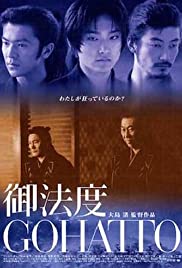
GOHATTO/ TABOO
Japan, 1999, 100 minutes, Colour.
Takeshi Kitano.
Directed by Nagisa Oshima.
Critics praised Taboo for its 'formal excellence', its 'stylised visuals', its Samurai theme. Celebrated Japanese director (In the Realm of the Senses, Merry Christmas, Mr Lawrence) Nagisa Oshima, far from inviting his audience to share in the life and emotions of the movie's protagonists, narrates an account of Samurai selection and training in the 1860s..
It is not that the characters do not have emotions - the movie focuses on homosexual feelings and jealousies amongst warriors and officers, 'Taboos' - but that they are generally not shown on screen. The characters are spoken about. They move in an externally impassive manner, keeping and concealing their inner lives for themselves. It is left for the audience to make the connections and to bring their own subjective responses to evaluate the relationships and interactions of the characters.
In fact, it is only in the fight sequences (training and actual) where the emotions are permitted to surface. Perhaps they are not permitted, it is just that in the art of fighting, aggression, antagonism and assertion have a legitimate channel of expression.
This is a different Samurai film. While there are battles, it is the Gohatto (Code of behaviour) for the warriors and their loyalty to the Shogunate which is the context for portraying relationships.